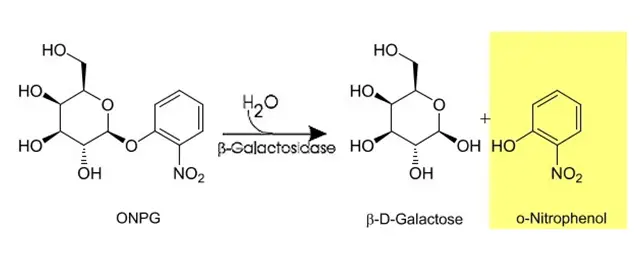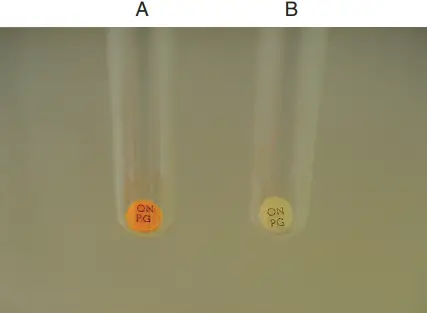Table of Contents
o-Nitrophenyl-b-D-Galactopyranoside (ONPG) Test Overview
- In order for bacteria to ferment lactose, two enzymes, permease and beta-galactosidase, must be present.
- Lactose is transported into the bacterial cell wall by permease and subsequently hydrolyzed by beta-galactosidase into glucose and galactose.
- bacteria are able to digest glucose and galactose.
- Some organisms, however, appear to be late or non-fermenters because they lack permease.
- To determine whether or not a sample contains the late lactose fermenter enzyme -galactosidase, the ONPG test can be performed (Late lactose fermenters are very difficult to distinguish from non-lactose fermenters because both appear under form colourless colonies on MacConkey agar).
- In order to ferment lactose, microorganisms need transporters (b-galactoside permease) and hydrolases (b-galactosidase) that can convert lactose to glucose and galactose.
- Late-lactose fermenters are organisms that have been genetically changed in some way so that they no longer produce b-galactosidase.
- Without the permease, ONPG cannot enter the cells of some creatures, but those organisms may hydrolyze ONPG into galactose and a yellow chemical, o-nitrophenol, which indicates the existence of b-galactosidase.
- Lactose is structurally identical to O-Nitrophenyl—D-galactopyranoside (ONPG), which is an analogue of lactose in which orthonitrophenyl has been substituted for glucose.
ONPG Test Purpose
- This test is used to detect the ability of an organism to produce b-galactosidase, an enzyme that hydrolyzes the substrate o-nitrophenyl-b-D-galactopyranoside (ONPG) to form a visible (yellow) product, ortho-nitrophenol.
- The test can identify Enterobacteriaceae that ferment lactose late vs those that ferment lactose early.
ONPG Test Principle
- It is important to note that ONPG (Ortho-nitrophenyl beta-D-galactopyranoside) is a synthetic, colourless molecule (galactoside) that is structurally similar to lactose.
- ONPG is a yellow chemical that is cleaved by -galactosidase positive organisms to yield galactose and o-nitrophenyl.
- When it comes to finding hidden lactose fermenters fast, the ONPG test is invaluable (late fermenters).
- The lactose fermenting ability of an organism is a common criterion for classifying members of the family Enterobacteriaceae, making the ONPG test relevant in this case.
- Bacteria and yeasts are separated in ONPG Broth according to their ortho-nitrophenyl beta-D-galactopyranoside utilisation rates.
- The structure of ONPG is comparable to that of lactose. Lactose fermentation can only be proven with a standard test in the presence of two enzymes.
- The first enzyme, permease, allows lactose molecules to enter the bacterial cell, where they are then hydrolyzed by the second enzyme, -galactosidase, into glucose and galactose.
- Both enzymes are absent in true non-lactose fermenters, but certain species lack permease but have -galactosidase. These microbes digest lactose very slowly.
- Nitrogenous substances, long-chain amino acids, and other growth factors can all be obtained from casitose. Phosphate acts as a medium buffer. The osmotic equilibrium is preserved by sodium chloride. An enzyme called -galactosidase requires a substrate, which in this case is ortho-nitrophenyl beta-D-galactopyranoside.
- In the presence of the enzyme b-galactosidase, the b-galactoside bond is broken, resulting in the release of galactose and a yellow molecule called o-nitrophenol.

Requirements for ONPG Test
- Test organisms-Gram-negative rods growing aerobically or Gram-negative diplococci growing aerobically
- ONPG broth
- ONPG disk
- Test tubes
- Inoculating loops
- Sterile saline
- Incubator
- Control strains to check quality control of test
ONPG broth Composition
| Ingredients | Gms / Litre |
| Casitose (Equivalent to Casein Peptone) | 7.500 |
| O-Nitrophenyl-β-D-galactopyranoside | 1.500 |
| Disodium hydrogen phosphate | 0.350 |
| Sodium chloride | 3.750 |
| Final pH ( at 25°C) | 7.5±0.2 |
ONPG Test Procedure
ONPG broth method
- Bring the medium to be tested to room temperature.
- Heavy inoculum from a pure 18–24 hour culture should be used to start the test medium.
- At 35–37oC, incubate in air with loose caps.
- At 1 hour, look to see if the colour is turning yellow.
- If the colour of the tube hasn’t changed after 1 hour, keep it in the incubator for up to 24 more hours.
ONPG disk method
Discs made of ONPG-impregnated sterile filter paper are known as ONPG discs. The structure of ONPG is comparable to that of lactose. Lactose fermentation can only be proven with a standard test in the presence of two enzymes. Lactose molecules enter the bacterial cell with the help of the first enzyme, permease, and are then hydrolyzed by the second enzyme, beta-galactosidase, producing glucose and galactose. However, there are certain species that lack permease but do have beta-galactosidase, so the term “non-lactose fermenters” might be misleading. These microorganisms digest lactose very slowly.
- Place one ONPG disc in a sterile test tube.
- Add 0.1 ml of sodium chloride solution that is sterile and 0.85% w/v (physiological saline).
- With a sterile loop, pick up the colony under test and mix it with physiological saline in the tube with the disc.
- Incubate at 35-37°C.
- To find lactose fermenters that are working, look at the tube every hour for up to 6 hours.
- Incubate the tubes for up to 24 hours to find late lactose fermenters.
Note: The speed of the reaction depends on how much of the inoculum is used. Use organisms that are known to make positive and negative beta-galactosidase to watch how the discs react.
ONPG Test Result
- ONPG Positive test: A positive ONPG test shows a yellow hue (indicating the presence of -galactosidase).
- ONPG Negative test: Colorless (absence of enzyme)

A, Positive. B, Negative.
| Organism | ONPG test |
| Salmonella Choleraesuis | Positive reaction: yellow colour |
| Citrobacter freundii | Positive reaction: yellow colour |
| Enterobacter aerogenes | Positive reaction: yellow colour |
| Klebsiella aerogenes | Positive reaction: yellow colour |
| Escherichia coli | Positive reaction: yellow colour |
| Proteus vulgaris | Negative reaction: no colour change |
| Shigella | Positive reaction: yellow colour |
| P. cepacia | Positive reaction: yellow colour |
| P. maltophilia | Positive reaction: yellow colour |
| Pseudomonas (most) | Negative reaction: no colour change |
| Salmonella Typhimurium | Negative reaction: no colour change |
Quality Control
- Positive control (PC): Escherichia coli ATCC 25922, Neisseria lactamica ATCC 23971
- Negative Control (NC): Proteus mirabilis ATCC 12453, Neisseria gonorrhoeae ATCC 43069
ONPG Test Limitations
- Any and all test organisms must be infected with a solution containing lactose (e.g., TSI or MacConkey).
- This medium is not suitable for testing cultures that produce yellow pigment naturally.
- Colonies from pure culture should be tested using biochemical, immunological, molecular, or mass spectrometric methods for definitive identification.
Keynotes on ONPG Test
- A positive ONPG test result indicates that the organism is a lactose fermenter, and the colour yellow indicates that the organism is a colour producer.
- A non-yellowing ONPG test indicates that the organism is not lactose fermenting.
- Neisseria lactamica is positive for ONPG among the Neisseria species.
References
- Cowan & Steel’s Manual for identification of Medical Bacteria. Editors: G.I. Barron & R.K. Felthani, 3rd ed 1993, Publisher Cambridge University Press.
- Colour Atlas and Textbook of Diagnostic Microbiology. Editors: Koneman E.W., Allen D.D., Dowell V.R. Jr and Sommers H.M.
- Mackie and Mc Cartney Practical Medical Microbiology. Editors: J.G. Colle, A.G. Fraser, B.P. Marmion, A. Simmous, 4th ed, Publisher Churchill Living Stone, New York, Melborne, Sans Franscisco 1996.
- Tille P.M. 2014. Bailey and Scott’s diagnostic microbiology. Thirteen edition. Mosby, Inc., an affiliate of Elsevier Inc. 3251 Riverport Lane. St. Louis. Missouri 63043
- https://himedialabs.com/TD/DD008.pdf
- https://himedialabs.com/TD/M1930.pdf
- https://universe84a.com/onpg-test/
- https://www.bio-rad.com/en-in/sku/3553822-onpg-test-beta-galactosidase?ID=3553822
- https://jcp.bmj.com/content/26/11/821
- https://www.cabdirect.org/cabdirect/abstract/19642702758
- https://www.keyscientific.com/files/New%20Website%20Files/ONPG/K490-1203.PDf
- https://microbiologie-clinique.com/ONPG-test-en.html
- https://microbiologyinfo.com/onpg-test/
